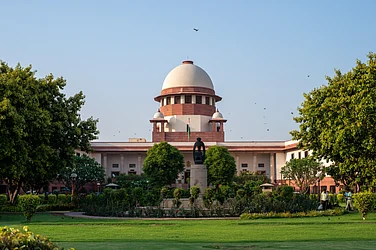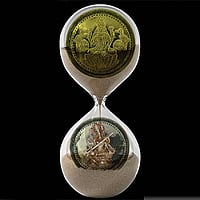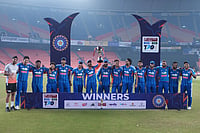In the world of political ideology, Shiva is a historical character who lived in Tibet around 10000 BCE, at the end of the last Ice Age. Events in the Ramayana and the Mahabharata occurred around 7000 BCE and 3000 BCE. To nationalist novelists and mystical marketeers, Shiva must therefore be recognised as Bharat’s first spiritual action hero, worthy of monumental temples.
In traditional understanding, however, where history is not a burden to bear, Shiva is the timeless self-created source of Vedic as well as tantric wisdom. In Tamil temples, we find Shiva as Dakshinamurti, seated under a banyan tree, facing south, educating sages as a teacher. His dance becomes a medium through which knowledge is transmitted, with ritualists who had forgotten the meaning of the Vedic rites. This understanding of Shiva, however, is not timeless. It is more recent than we think.
Every mythology has a history
There is a Harappan seal of a man with bangles on his hand and horns on his head seated in yogic posture surrounded by wild animals. This is dated to 2500 BCE and some academicians believe it alludes to a kind of proto-Shiva. But this is just speculation. To archaeologists, Harappan cities ceased to exist around 2000 BCE. For geneticists, bands of male Steppe pastoralists, popularly referred to as Aryans, entered India in waves around 1500 BCE and married local women. In all probability, their children composed the Rigveda, which reached its final form around 1000 BCE.
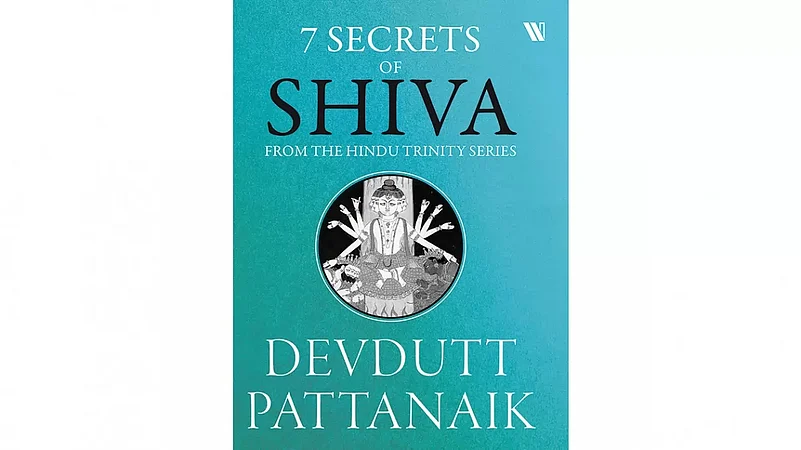
Rigveda refers to a Rudra, a wild and fierce deity, associated with cattle and medicines. Can he be Shiva? There is no reference to him destroying any yagna, or having a family, or residing in the Himalayas. Rigveda also refers to a Daksha as the father of the gods. But there is no reference either to Sati or to him being Shiva’s father-in-law. There are fragments of tales in later Vedic literature alluding to a father who chases his daughter and a hunter pinning him to the sky with an arrow, as if he is a buck chasing a reluctant doe. One can only speculate if these fragments were eventually fleshed out in Puranic lore, composed after 500 CE.
Vedic culture was not pan-Indian. It thrived in the Gangetic plains, in regions now called Haryana, Uttar Pradesh and Uttarakhand, between 1000 BCE and 500 CE, as indicated by the presence of painted greyware pottery. This is when events took place that may have later inspired the composition of the Mahabharata and the Ramayana. Life was centred around the ritual of yagna that involved feeding devas (hungry gods) and pitr (hungry ancestors) at a fire altar and seeking their grace for worldly success.
This worldview was challenged by the Buddhist and Jain monastic orders that rose in the region now called Bihar around 500 BCE. Monks sought to outgrow hunger itself and thus overcome all worldly yearnings and sufferings. They were expected to keep travelling, never staying in one place for more than one night, except during the rainy season, when they could take refuge in cave shelters. They travelled with merchants along India’s trade routes, and their ideas spread to markets located in ports, along coasts and India’s many river deltas: Mahanadi, Godavari, Narmada, Krishna, Kaveri. Here we find the earliest artworks of India—all Buddhist or Jain.
The Vedic world had no love for iconography. Vedic fire altars and ritual halls would be set aflame after ceremonies. This is why Vedic culture has left behind very few artifacts for archaeologists. By contrast, Buddhist and Jain communities carved prayer halls and monasteries and shrines into rocks to the delight of the historian.
We know next to nothing of the stories, and rituals, of non-Brahmin people who lived in the rest of India at this time, with whom Vedic Brahmins had little interaction; they preferred the company of elites who provided them with food, and fee, in exchange for their services as ritualists. Buddhists and Jains, on the other hand, went to all houses seeking alms, which explains their early popularity. The spread of Buddhism is revealed by a legend. In the 3rd century BCE, the Mauryan king is said to have established 84,000 stupas containing relics of the Buddha across his empire and beyond. This is perhaps the earliest instance of faith being used for marking territory. By the 8th century CE, i.e. a thousand years later, the Hindus had a similar tale.
Hermit to householder
Ancient Vedic lore was insular, restricted to, and carefully guarded by, a small community of Brahmins who lived in the Gangetic plains for centuries before they spread out like Buddhist and Jain monks. We know of this Vedic migration only through folktales of intrepid rishis like Agastya, Dirghatama and Parashurama. During this migration, the Brahmins realised they had to reimagine themselves if they had to stay relevant. This led to the Vedic grihapati, who fed the gods and the ancestors, reinventing himself as the grishastha of the dharma shastra (code of conduct), who saw family life as a duty, superior to renunciation.
ALSO READ: Shiva The Consciousness And The Bliss
This transformation was communicated to all through stories of Shiva, compiled in the Puranas and illustrated on temple walls. The earliest artworks that reveal this reimagined Hinduism through Shiva are dated to the 8th century. They are found in the Elephanta Caves near Mumbai, on the walls of the Kailasanatha Temple in Kanchi and the roof of the Shatrug–haneshwar Temple in Bhubaneshwar, i.e., on the western, southern and eastern corners of India.
The rejection of the old Vedic way was indicated by the beheading of Daksha, who did not welcome Shiva into his fold, and the desecration of his yagna. The rejection of monastic orders was indicated by celebrating the conjugal life of Shiva with Shakti. Buddha and Tirthankaras were householders who became hermits. Shiva was a hermit who became a householder.
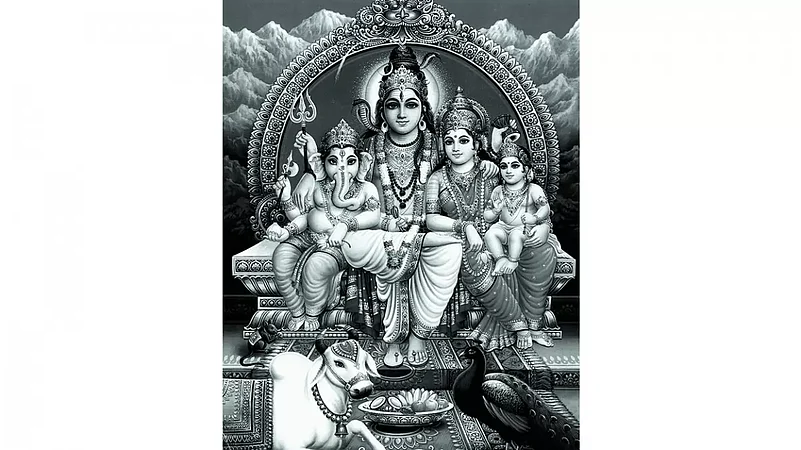
In the 8th century, the great Vedanta scholar, Adi Shankara, travelled from Kerala through the Narmada valley and the Gangetic plains to Badrinath and Kashmir. He spoke of 12 spots across the subcontinent where Shiva emerged from an endless pillar of fire. These were the Jyotirlinga. Why pillar? Because since Mauryan times, pillars were used by kings as symbols of their authority. But their pillars were no match for the limitless fiery linga of Shiva.
Adi Shankara described Shiva as Mahadeva, greater than the Vedic devas, as he was never hungry and so did not need food. He was thus much like the Buddhas and Tirthankaras who, having outgrown hunger, lived in Siddha loka, beyond the heaven of the 33 Vedic gods. In his compositions, Adi Shankara described Shiva as swayambhu (self-created), untouched by birth or death, hence having no ancestors or children. But this transcendental view lacks the sensuality of the stories and art around Shiva.
In the temples of Bhubaneshwar, Shiva is shown as ithyphallic, distinguishing him from the naked Jain ascetics and the clothed Buddha. How can someone who desires nothing display such arousal? This was an artistic way of showing the latent power generated through monastic practices. It needed channelling. And this happened through the goddess. For Shiva was sensitive to the human condition, human hunger and human mortality, just like the Bodhisattva of later Mahayana Buddhism. But unlike the Bodhisattva, Shiva marries. Twice.
Shiva’s first wife, Daksha’s daughter, Sati, married him against her father’s will. Exhausted by her father’s need to control, and her husband’s total indifference, she killed herself on a Vedic fire altar. This ignited rage in the compassionate Shiva. He disrupted the Vedic ceremony and beheaded Daksha. Later, feeling sorry for the hungry devas, he restored the yagna, and resurrected Daksha. He then wandered the earth carrying Sati’s corpse. The corpse was cut by the gods to stop Shiva’s mourning. Wherever a body part fell, a sacred spot emerged—the Shakti Peetha (seat of the Goddess). These sacred spots connected by pilgrim routes expanded Aryavarta from its Gangetic confines to the entire subcontinent, from the Himalayas to the ocean. The body parts of Sati thus established a new Hindu world, much as Buddha’s relics established the old Buddhist world. Buddha’s relics would migrate with travelling merchants. Sati’s body, however, would merge with the soil, anchor Shiva’s fiery linga, and bind Hinduism to the land, to mountains and to rivers and farms.
While Shiva used his third eye to kill Kama, the God of desire, Parvati, the daughter of the Himalayas, turned into an ascetic and used asceticism to goad Shiva to give up his hermit ways and be her husband. While Sati left her father’s house to come to Shiva, Parvati uses devotion to make Shiva come to her father’s house as a groom. These details, found in the Puranas, reveal so much about the historical processes that elude those who shun mythology.
With Parvati by his side, Shiva pays more attention to worldly problems. He captures the river Goddess, Ganga, who falls from the heavens into his matted locks. Her waters that flow gently towards the sea hold the promise of rebirth. Thus began the practice of immersing ashes of the dead in river water, a practice unknown in the Grihya-sutras (500 BCE), but mentioned in the Garuda Purana (1000 CE). In Tamil poetry dated to the 12th century, we learn of ghosts who are companions of the Goddess, who fed them the flesh of those killed in battle. But then, through her husband Shiva, and Ganga, rebirth is enabled and the world changes forever. Shiva became Mahakala, the one who conquers time, conquers death, by offering the promise of rebirth and freedom from the wheel of rebirths.
These were new ideas spread across India from the many temples built by kings, encouraged by Brahmins. Temples enshrining Shiva were a new way to establish royal authority across the river basins of India. Shiva enabled kingship by turning war into a sacrifice for his consort, and offering continuity to the land. Kings would come and go, but Shiva would remain with his consort, forever. The new prince, like Shiva’s son, Skanda, would become the next Shiva. Ganesha, like the elephant corps of the royal army, would clear the paths for the king’s soldiers and block the path of the king’s enemies.
Eclipsed by Vedanta
Why is this history of Shiva not known to most Indians? It is because Hindus found themselves in the unenviable position of having to explain their faith to their colonial masters. Worse, the explanation had to follow the Christian and the Islamic framework. There had to be one God, a rule book and a priest who regulated the religion. And so a new Hinduism was constructed in the 19th century that privileged the Vedas, especially the Upanishads, and overplayed the role of the Brahmin in Hindu society, making them spokespersons of all things Hindu.
Amongst all things Upanishad, the Advaita came closest to monotheism. While Adi Shankara identified jyotirlinga sites and composed hymns to Shiva, he essentially saw all imagery of the divine as maya (delusions) that had to be shattered in the quest for the formless, unfettered aatma. To use contemporary language, like ancient Greek philosophers, Adi Shankara valued philosophy over
mythology—and this made him a role model for Hindu reformers in the 19th and 20th centuries.
Even today, in elite Hindu circles, the abstract Advaita is seen as essentially superior to other forms of Vedanta. Puranic stories and temple art and rituals evoke idolatry and are shunned by atheists and rationalists. Mythology remains the stepchild of academia. Most senior historians in the most celebrated universities of India continue to hold mythology in contempt. Only now, a new generation of scholars is realising how much historical information is locked in the mythological art of Indian temples. Unfortunately, history as a subject is being actively discredited by nationalists. Historians have been accused of using their scholarship for political manipulation and activism, valorising all things Buddhist and Mughal over anything Hindu.
Mythology is about ideas, not events. We forget that Shiva is present in both the Ramayana and the Mahabharata. In the Ramayana, Shiva crushes the arrogance of Ravan who tries to carry Mount Kailash to the south. In the Mahabharata, Shiva humbles the privileged Arjun in the form of a kirata or tribal youth. This cannot be explained historically. But it makes perfect sense mythologically. For Shiva embodies the idea of detachment, churned by ascetic practices. Just as Buddhist monks sought to restrain mercantile greed, Vedic Brahmins sought to balance royal hubris and entitlement with ideas of governance and generosity. Through stories and artwork, they sought to transform the king into the tapasvi raja (hermit king), a title often associated with Ram of the Ramayana. This escapes the very people needing it the most today—ambitious, arrogant and entitled politicians who prefer to imagine Shiva, and themselves, as the spiritual action heroes of talented fiction writers and mystical marketeers.
(This appeared in the print edition as "Between Myth And History")
(Views expressed are personal)
Devdutt Pattanaik is the author of 50 books on mythology












